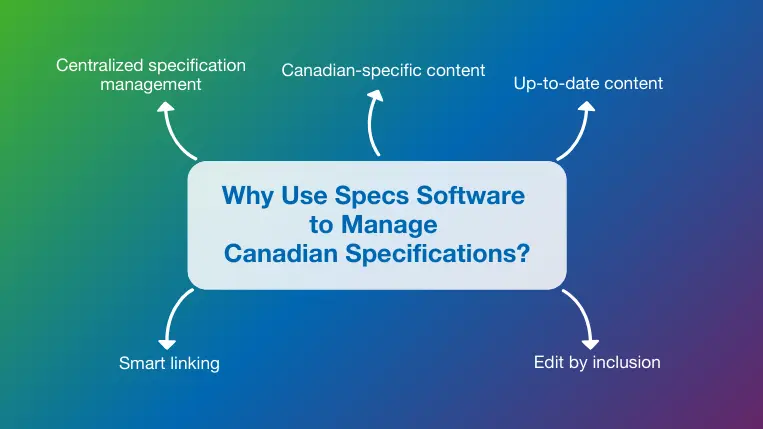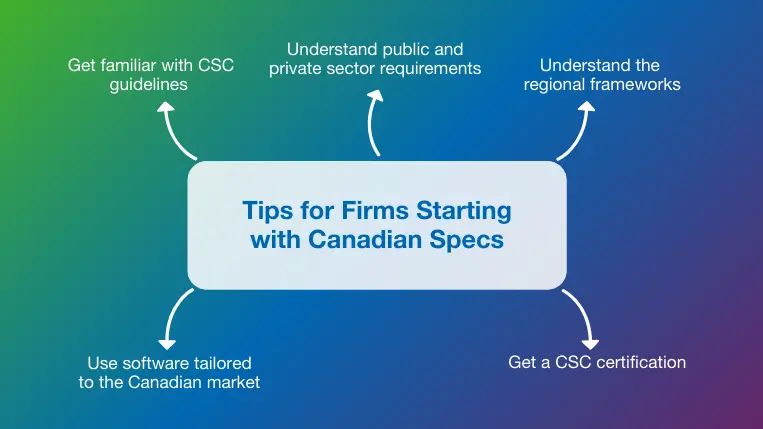11 mins read
Decoding Construction Specifications in Canada: What You Need to Know

Construction specifications are the backbone of any successful building project. They detail the materials, systems, and workmanship required to bring a design to life. In Canada, writing specs involves navigating a unique framework of national and regional standards, industry best practices, and professional guidance.
To help companies just getting started in the Canadian spec environment, we’ve put together this insightful blog post that provides an overview of how the system works and how it can be easily and efficiently navigated using the right software solutions.
Most of the topics discussed in this blog have been previously discussed in one episode of our webinar series, RIB SpecTalk, called “Specifications in Canada”. The discussion featured Jason Hicks, RIB’s Canadian Professional Content Manager, who brings a wealth of experience as an architectural technologist and seasoned spec writer. Jason’s insights shed light on the challenges and opportunities within the Canadian construction industry. Watch the episode below for a more interactive experience with visual examples and read the blog for additional insights!
Construction Specifications Canada: An Overview
Construction specifications in Canada are guided by standardized frameworks and resources that help with consistency and quality. They complement architectural and engineering drawings by describing products, materials, systems, equipment, workmanship, construction methods, quality standards, and all other relevant details that must be followed for the project to be compliant and successful.
In Canada, specs are shaped by nationally recognized systems and organizations, two of them being the CSC and the NMS.
Construction Specifications Canada (CSC)
Founded in 1954, the CSC is the Canadian equivalent of the CSI in the United States. The non-profit membership organization was created by architects, engineers, and spec writers to improve and standardize Canadian construction specifications and offer members education, certifications, and networking opportunities. The CSC belongs to the Canadian Construction Documents Committee (CCDC) and has contributed to developing various relevant standards and frameworks used in Canada, the most important being MasterFormat, which was created in collaboration with the CSI.
MasterFormat is a system of numbers and titles used to clearly organize and communicate construction project information. The standard divides the information into 48 divisions, each representing a category, such as HVAC, masonry, electrical systems, plumbing, etc. Each division is further broken into sections, each divided into a three-part format for articles titled General, Products, and Execution. Additionally, MasterFormat uses a six-digit section numbering system where divisions are the first two digits, sections are the middle two digits, and subsections are the last two digits.
In addition to the standards, the CSC offers some valuable courses:
- Specifier Course (SPEC): Offers a complete and comprehensive overview of the profession of specifications in Canada.
- Certified Specification Practitioner (CSP): A recognition for specification writers to show they are serious about creating high-quality specs. It requires the completion of two other CSC courses.
- Registered Specification Writer (RSW): Recognition for professionals who prepare or supervise the preparation of construction specs. Candidates must complete the CPD and SPEC courses to get this recognition.
- Certified Technical Representative (CTR): Professional certification for individuals who market and distribute products for construction.
- Certified Construction Contract Administrator (CCCA): Recognition for professionals managing construction contracts, including architects, engineers, interior designers, specification consultants, and other construction roles.
National Master Specification (NMS)
Developed by the Public Services and Procurement Canada (PSPC), the NMS is the country’s most comprehensive master specification system. It offers a structured framework with over 100 design master specifications and 750 construction master specifications in English and French to adapt to specific project requirements. The NMS is mandated for most government-funded projects. However, it is also available for public or private sector organizations to prepare construction or renovation contract documents.
Why Use Specs Software to Manage Canadian Specifications?

RIB SpecLink is a powerful specifications software that has been helping architects, engineers, specifiers, and other construction professionals manage specs for over 30 years. It allows them to digitize and automate the spec writing process, saving a wealth of time compared to traditional tools like Word.
Our platform is a proud partner of Construction Specifications Canada (CSC) and the Royal Architectural Institute of Canada (RAIC). We offer up-to-date Canadian specification content to ensure specs are compliant and efficient across the board. Other benefits include:
Centralized specification management: Rather than functioning like a linear word processor, SpecLink is a database system with interconnected specifications. This means that all specification data and documentation are hosted in a single database, allowing users to link data between sections, reuse data across projects, make consistent global changes and edits, and create project templates and Office Masters with a lot more efficiency.
Canadian-specific content: SpecLink offers a content library for both the United States and Canada. The content categories include procurement and contracting documents, design criteria documents, and construction specifications. All Canadian-specific content has been harmonized with the Canadian Construction Documents Committee (CCDC). Earlier this year, the NMS standard, from the National Research Council of Canada, was included in SpecLink’s content library. The NMS is mandatory for all federal government-funded work, making its integration into SpecLink an invaluable asset.
Up-to-date content: RIB SpecLink has a team of over 15 spec writers who continuously update reference standards and manufacturer or product updates. Thanks to the platform’s web-based nature, you can easily integrate those updates into your master spec templates without having to manually go and find the information yourself.
Edit by inclusion: SpecLink offers an edit-by-selection system that allows users to activate the sections and content they want to use, instead of deleting the content they don’t need to use. This approach streamlines the editing process, reduces errors, and ensures consistency across specifications. It is ideal for adapting to different regional or project-specific needs, including Canadian specification formats.
Smart linking: The software incorporates over 300,000 intelligent links between related paragraphs and sections. In fact, that is where the name “SpecLink” comes from. Our smart linking technology automatically activates related or relevant content once a section is activated, ensuring no relevant content is overlooked and significantly reducing manual work. The feature is especially valuable for complex projects with large specs or users adapting to different formats like NMS or CMS in Canada.
Tips for Firms Starting with Canadian Specs

Now that you understand how the Canadian specs system works, let’s review some tips to get you started on the right foot. Using professional software like RIB SpecLink should be the first step in the process, as this powerful tool will give you unmatched levels of precision and speed while reducing the risk of errors and increasing communication and overall success. Paired with that, you should:
Get familiar with CSC guidelines
As mentioned, most Canadian construction projects are guided by CSC principles and standards. Therefore, becoming familiar with these values helps firms align with national best practices and ensures their documentation suits Canadian stakeholders. It also helps improve communication with other professionals already working with this framework and provides a standardized approach to spec management.
Understand public and private sector requirements
Just like in any other country, specs in Canada have different requirements and structures depending on whether they are for a public or private project. Therefore, understanding the requirements for each case is fundamental for success. Most public-sector projects mandate the use of the NMS, as it includes content and instructions tied to government frameworks. On the other hand, private-sector projects offer more flexibility, as they are more focused on speed and performance than compliance.
Understand the regional frameworks
Expanding on the point above, understanding any regional requirements is equally important before entering the Canadian specifications environment. For example, the Alberta Building Management Specification (BMS) is required for provincial government projects in Alberta. Likewise, other cities have specific building codes or standards that must be followed, like the Ontario Building Code (OBC) or the Société québécoise des infrastructures (SQI) for public projects in Québec.
Get a CSC certification
Formal education and mentorship from the CSC can become a recipe for success for firms in the Canadian construction industry. Each of the CSC courses and certifications described earlier in the blog offers foundational knowledge as well as a certification to validate that knowledge, increasing credibility and trust with clients in the Canadian market.
Use software tailored to the Canadian market
To efficiently produce Canadian-compliant specifications, firms should adopt tools that support the formats and terminology used in Canada. RIB SpecLink is the chosen software by Canadian firms as it supports Canadian formatting and standards while offering powerful features like smart linking, intelligent editing, web-based collaboration, automation, and much more. To learn more about the features, check our blog about RIB SpecLink basics.
RIB SpecLink: The Best Canadian Specs Software
Canadian specs can be easily managed with the right software and technology. RIB Software has an ongoing partnership with the CSC, offering access to top-tier specification software, RIB SpecLink, as well as educational resources and master content, including the National Master Specification (NMS), the most comprehensive master guide for Canadian projects. RIB and CSC are committed to innovation, quality, and efficiency across the construction industry. Their longstanding relationships with the Construction Specifications Institute (CSI) helped lay the foundation for this strategic alliance, designed to empower design professionals with the tools and content they need to succeed.
If you are interested in experiencing what a powerful platform like RIB SpecLink can do for your firm, get your free demo today!

Most Recent
11 mins read
11 mins read
10 mins read
10 mins read
Blog Categories

Ebook











